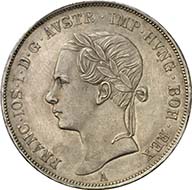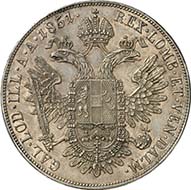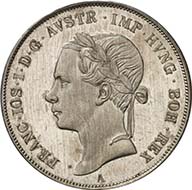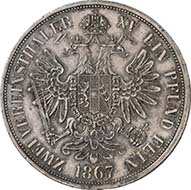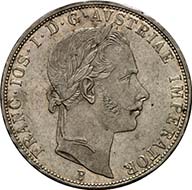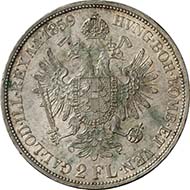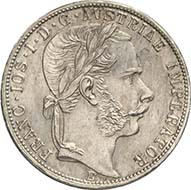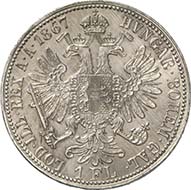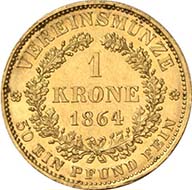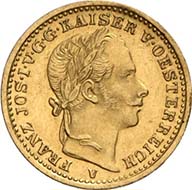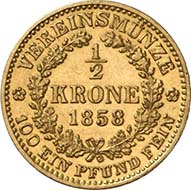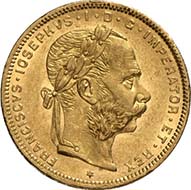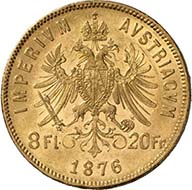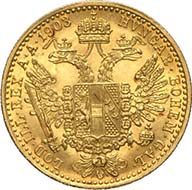The year is 1857. Franz Joseph married his Sisi not even three years ago, the foundation stone has been laid for the Votive Church, and there is a lively discussion going on about the demolition of the old fortifications. It is evident that Vienna recovers from the repercussions of the revolution of 1848. The informers experience a boom again (even though they are euphemistically called “confidants” now), and delegates from all important states of Germany sign a contract destined to shape the modern monetary system.
Konventionsthaler 1851 A, Vienna. J. 290. From Künker sale 195 (September 28, 2011), 4395. About brilliant uncirculated. Estimate: 5,000 Euros. – The konventionsthaler were uncommon in the domestic Austrian payments. They were minted for accumulation and the foreign trade.
Until then, Austria got left out regarding the German economy. Prussia automatically assumed leadership in that section, too. Yes, Austria had slid into economic and political isolation and needed to participate in the monetary negotiations to get a seat in the German Customs and Trade Union in order to reclaim its rights for hegemony in the German Confederation.
Konventionsthaler 1848 A, Vienna. J. 290. From Künker sale 195 (September 28, 2011), 4393. About brilliant uncirculated. Estimate: 5,000 Euros. – The extremely rare coinage – known are 10 pieces each with the years 1848, 1849, 1850, 1851 and 1852 – showing the portrait of the emperor to the left were all produced as patterns in 1852. Because the emperor didn?t like his portrait, this type wasn?t issued. The coins were given to the emperor, public coin cabinets and high-ranking private individuals.
These politics were initiated by Karl Ludwig Freiherr von Bruck (Minister of Commerce and Public Works 1848-1851; Minister of Finance 1855-1860). He was one of the great thought leaders of the Gründerzeit (‘Founder Epoch’). To him, Austria owes its Lloyd, the Shipping Company with which Austria controlled the Eastern Mediterranean. Chambers of trade and professions traces back to him; he improved the infrastructure by building streets and railways and modernized the postal and telegraphy system. Bruck was the driving force behind numerous reforms, which led Austria’s economy into the modern age.
Double vereinsthaler 1866 A, Vienna. J. 317. From Künker sale 195 (September 28, 2011), 4443. About extremely fine. Estimate: 600 Euros. – The double vereinsthaler after the Vienna Coinage Contract were allowed to circulate in all countries involved.
As early as 1850, Bruck had initiated a Customs Union between the German crown states, i.e. Austria, and the states of the Hungarian crown. Two years later, a customs system was introduced in this economic area, which was so similar to the German Customs Union that a fusion would have been possible, with only minor things changed, which Bruck negotiated in Berlin since 1853, by the way. Berlin, however, harbored doubts. Prussia’s industry would have entered new markets, of course – the new association was said to incorporate roughly 70 million potential customers –, but it would have gotten itself a rival about the hegemony at the same time. What was to the disgust of the Prussian ministers, the central states received with cheers. An open power struggle between Prussia and Austria would provide an opportunity to bring one’s own interest to more attention.
A breakaway and two customs unions were imminent – one led by Prussia, the other one by Austria; but literally at the last minute, the ones responsible found a diplomatic solution: Austria became member of the Customs Union. The hegemony question was placed on hold.
Double gulden, 1859 B, Kremnitz. J. 329. From Künker sale 195 (September 28, 2011), 4445. Extremely fine. Estimate: 150 Euros. – One Austrian double gulden after the Vienna Coinage Contract equated 2/3 Prussian thaler.
In the meantime, Austria had to do its homework. Salaries were paid not in silver but in banknotes there. Anyone wanting to exchange silver or gold, which was produced exclusively for the trade with foreign countries, was faced with an average disagio of 25 percent. The salaries remained stable, which meant to the Austrian people that foreign products were 25% more expensive than domestic goods.
Gulden 1867 E, Karlsburg. J. 335a. From Künker sale 195 (September 28, 2011), 4536. Extremely fine to brilliant uncirculated. Estimate: 20,000 Euros. – This specimen from Transylvanian Karlsburg (Alba Iulia) is the rarest silver coin of the gulden currency.
Austria, therefore, had the edge which was why the German states agreed to the contract only under the condition that Austria restored its currency, as it is said in paragraph 19: “The rivaling states will enter negotiations about a general coinage convention in the course of 1853.”
Vereinskrone 1864 A, Vienna. J. 315. From Künker sale 195 (September 28, 2011), 4174. Extremely fine to brilliant uncirculated. Estimate: 7,000 Euros. – The vereinskrone of 10 g wasn’t very popular: compared to the silver coin, it had no fixed exchange rate and a different standard than the popular French franc. No wonder than this emission from 1864 consisted of 1,530 specimens only.
Austria wanted to return to a metal currency, which couldn’t be done instantly. Too much money had to be raised. Serious negotiations, therefore, were entered as late as October 1856, with Prussia at first, Bavaria, Saxony, Hannover and Frankfurt. Only when the “Big Six” had reached an agreement on the general issues, the other states were admitted on December 9, 1856.
1/2 vereinskrone 1858 V. Venice. J. 314. From Künker sale 195 (September 28, 2011), 4176. Extremely fine. Estimate: 25,000 Euros. – Even more unpopular was the half vereinskrone. This specimen wasn’t minted in Vienna but in Venice with a mintage of 947 pieces.
Hot-button issue was the question whether the currency ought to be based on silver or on gold. Austria vehemently favored a gold currency. The reason were the huge gold deposits in California that made the gold price, compared with silver, drop significantly. Austria hoped that a return from the paper to the metal currency would be paid easier thanks to the gold inflation. But Prussia insisted on the silver standard and prevailed.
8 gulden (20 franken) 1876, Vienna. J. 362. From Künker sale 195 (September 28, 2011), 4188. Extremely fine. Estimate: 200 Euros. – It’s easy to understand that only a few years later, Austria began minting coins compatible with the gold coins of the Latin Monetary Union.
On January 24, 1857, the Vienna Coinage Contract was signed. It contained a historical decision, which clearly led the way to present times: the Cologne mark of 233.8555 g was abandoned in favor of the metric pound as reference value. 30 thaler or 45 South German and 52 ½ Austrian gulden, respectively, ought to be minted from one pound of fine silver. Austria was granted the right to continue its minting of the Maria-Theresia-thaler for foreign trade. The simple and the double vereinsthaler adhering to the Prussian standard were permitted to circulate in the entire validity area: it was a huge success for the Prussian currency.
4 ducats 1859 A, Vienna. J. 298. From Künker sale 195 (September 28, 2011), 4023. Extremely fine to brilliant uncirculated. Estimate: 3,000 Euros. – According to the Vienna Contract, the production of ducats was permitted only until 1865.
The Vienna Coinage Contract provided for gold coins as well, albeit only for foreign trade. It was prohibited to officially fix an exchange rate at all for the crowns and half crowns that ought to be minted in the weight of 1/50 and 1/100 pound, respectively, fine gold. Their price ought to orient itself to the stock market price of gold. Austria obtained permission to continue its production of ducats until 1865.
The contract didn’t provide for paper money (yet). Contemporaries didn’t consider it money but commercial paper. It was, nevertheless, mentioned in a coinage contract for the first time: the issue of paper money – be it by the state or a private party – was permitted only when it was possible at all times to exchange the banknotes for silver money.
Ducat 1903, Vienna. J. 344. From Künker sale 195 (September 28, 2011), 4156. About brilliant uncirculated. Estimate: 125 Euros. – Ducats were actually produced for a longer period of time and can still be acquired at the Austrian Mint.
That, however, was and continued to be pious hope. Although the Austrian National Bank resumed cash down payment on September 6, 1858, but already the following year the Second Italian War of Independence began which deprived Austria of Milan after the Battles of Magenta and Solferino. It had generated huge cost, and the National Bank saw no alternative than to issue banknotes at a compulsory price a second time. That made the Austrian silver and gold coins a mere trading currency yet again.



